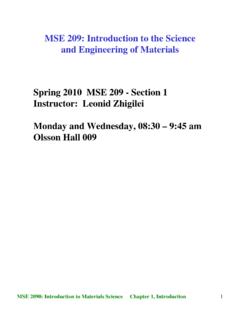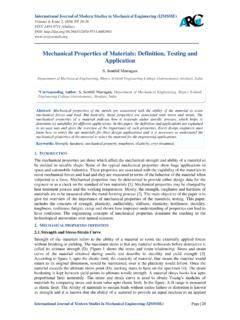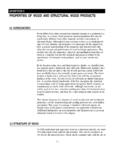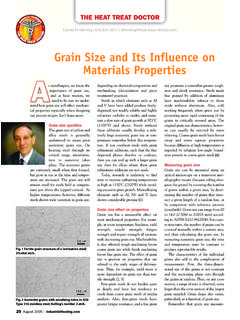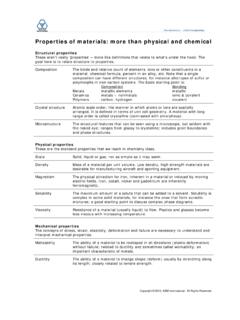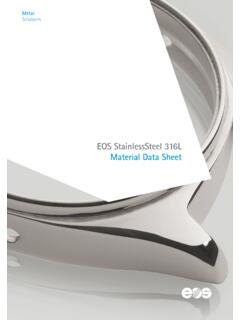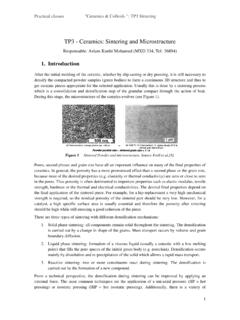Transcription of Mechanical Testing of Engineering Materials
1 Mechanical Testing ofEngineering Materials By Kyriakos Komvopoulos Included in this preview: Copyright Page Table of Contents Excerpt of Chapter 1 For additional information on adopting this book for your class, please contact us at x501 or via e-mail at Testing of Engineering Kyriakos KomvopoulosDepartment of Mechanical Engineering University of California BerkeleyCopyright 2011 University Readers, Inc. All rights reserved. No part of this publication may be reprinted, reproduced, transmitted, or utilized in any form or by any electronic, Mechanical , or other means, now known or hereafter invented, including photocopying, microfilming, and recording, or in any information retrieval system without the written permission of University Readers, published in the United States of America in 2011 by Cognella, a division of University Readers, Notice: Product or corporate names may be trademarks or registered trademarks, and are used only for identification and explanation without intent to 14 13 12 11 1 2 3 4 5 Printed in the United States of AmericaISBN: 978-1-60927-920-2 ContentsPreface vacknowledgments viichapter 1: heat Treatment 1chapter 2: indentation hardness 13chapter 3: Monotonic Tensile loading 27chapter 4: fracture Toughness 37chapter 5.
2 Time- and rate-Dependent Deformation 43chapter 6: Deformation due to cyclic loading 51chapter 7: fatigue Testing 61chapter 8: Wear Testing 73appendix a: report Template 85appendix B: rubric for assessing lab reports 93 vPrefaceThe Mechanical response of Materials to different external loadings is of great importance to many fields of science, Engineering , and industry. Structural failure is realized when the functionality of Engineering components has been depleted. In general, there are three main reasons for a compo-nent to become dysfunctional excessive (elastic or inelastic) deformation, fracture, and wear. Excessive elastic deformation is controlled by the elastic properties of the material, such as elastic modulus, and may occur under loading conditions of stable equilibrium ( , excessive deflection of a beam), unstable equilibrium ( , buckling of a column), and brittle fracture.
3 Excessive inelastic deformation depends on plastic material properties , such as ultimate tensile strength, strain hardening, and hardness, and may occur under loading conditions conducive to fatigue (a process involving alternating stresses (or strain) that induce crack initiation from stress raisers or defects in the material followed by crack growth), ductile fracture due to excessive accumulation of plastic deformation, and creep (a time-dependent deforma-tion process encountered with viscoelastic Materials and elastic-plastic Materials at elevated temperatures subjected to a constant stress). Material degradation may also occur as a result of Mechanical wear arising at contact interfaces of load-bearing components when the transmitted contact stresses are comparable of the material hardness. It is therefore important to not only know how the Mechanical properties control the material response to a certain external force, but also have knowledge of standard Mechanical Testing methods for measuring different material 1 is devoted to the modification of the material microstructure by heat treatment.
4 The chapter shows how equilibrium phase diagrams and time-temperature-transformation diagrams can be used to predict steel microstructures after a certain type of heat treatment. Chapter 2 is focused on hardness measurement and the interpretation of the hardness data in terms of microstructure differences. Chapter 3 provides insight into the extraction of elastic and plastic material properties of different Materials from uniaxial loading experiments. Chapter 4 treats fracture toughness measurement by impact Testing and correlation of toughness differences to microstructure variations induced by heat objective of Chapter 5 is the Mechanical behavior of viscoelastic Materials , particularly micro-structure effects on stress-strain and stress relaxation responses. Deformation due to cyclic loading is the theme of Chapter 6. Special attention is given to analyzing the data in the context of cyclic hardening (softening), plastic shakedown (constant plastic strain accumulation per cycle), and ratcheting (continuous accumulation of plasticity).
5 The purpose of Chapter 7 is to illustrate how to perform strain-control fatigue tests and how to correlate the measured fatigue properties to microstructure characteristics. Wear Testing is the theme of Chapter 8, particularly the recognition of different lubrication regimes, seizure mechanisms, lubricant behavior, and effect of load, temperature, and sliding speed on friction and wear properties of bearing sequence of the experiments included in this book is typical of most books covering this topic. A set of questions is included at the end of each chapter, which can be used to design laboratory assignments. A report template and a rubric for evaluating laboratory reports are included in Appendices A and B, respectively. It is presumed that the students who use this book have had elementary courses on mechanics and Materials sciences and, therefore, are familiar with such concepts as force and moment equilibrium, stress, strain, steel microstructures , and phase diagrams.
6 They should also be familiar with basic statistics and data acquisition and book should be a valuable supplement to an undergraduate-level course on Mechanical behavior of Materials . The emphasis is on Mechanical Testing according to established standards and the development of comprehensive reports of the obtained measurements. In addition to the necessary background and representative results, the book provides essential steps for carrying out each test. The coverage includes experiments drawn from the most important topics of an undergraduate course on Mechanical behavior of Materials . K. Komvopoulos Berkeley, California viiacknowledgmentsThe idea for this book emerged after teaching the undergraduate course on Mechanical behavior of Materials at the University of California at Berkeley for more than 20 years, recognizing the lack of understanding of basic concepts in the absence of hands-on experience and difficulties of the students to use classroom material to explain experimental findings in a comprehensive manner.
7 The book reflects the author s strong commitment to promote excellence in undergraduate teaching at UC Berkeley and to elevate student understanding of Materials book would not have been possible without the tireless efforts of many of my research students, who took precious times from their research to assist me in developing the experiments presented in this book. I am greatly indebted to H. Zhang, H. Xiang, N. Wang, X. Yin, Q. Cheng, Z. Song, H. Xu, and A. Poulizac who not only played pivotal roles in setting up the experiments and obtaining the representative results included in this book, but also supervising the students during the laboratory sessions over the past year and grading their also wish to acknowledge the support and encouragement provided by my Department. I especially thank Professor A. P. Pisano, Chair of the Department of Mechanical Engineering , for his continued interest on this project and for raising the funds to renovate the space where these laboratories are hosted.
8 I am also grateful to my colleagues Professors L. A. Pruitt and H. Dharan for donating an axial loading machine and an impact tester, respectively, for the experiments and their support throughout my efforts to create these laboratories. Lastly, my thanks go to Mr. S. McCormick for technical assistance, equipment service and upgrading, specimen fabrication, laboratory coordination, and, especially, for overseeing the work of my students during the development of the experiments. Chapter 1: Heat Treatment 1chapter 1: heat BackgroundSome basic information about phase diagrams and time-temperature-transformation (TTT) dia-grams of steels is presented first as background material for the heat treatment part of this lab. Information for heat treatment of various carbon steels can be found in the Appendix Phase DiagramsThe equilibrium phase diagram of Fe-C alloy system is shown in Fig.
9 [1].At eutectoid position ( wt% carbon composition, 748 C), the alloy undergoes the following phase transformation:Fig. Equilibrium phase diagram of carbon steel [1].2 Mechanical Testing of Engineering Materials If the composition is exactly the eutectoid composition (Fig. (a)), solid-solid phase transformation will occur upon cooling below 748 C, resulting in the formation of pearlite (Fig. (b)) [1]. However, if the composition is hypoeutectoid (Fig. (a)), then a phase will form first, while cementite will form after cooling below 748 C, resulting in a mixture of pearlite and a ferrite (Fig. (b)) [1].Fig. (a) Phase diagram of eutectoid carbon steel and (b) pearlite microstructure [1].(a)(b)Fig. (a) Phase diagram of hypoeutectoid carbon steel and (b) microstructure consisting of pearlite and a ferrite [1].(a) (b) Chapter 1: Heat Treatment 3In the case of hypereutectoid composition (Fig.)
10 (a)), cementite will form fi rst, whereas a ferrite will form upon cooling below 748 C, producing a mixture of pearlite and cementite (Fig. (b)) [1]. Time-Temperature-Transformation (TTT) DiagramsPhase transformation during heat treatment is also controlled by the cooling rate. At a fi xed temperature, it takes certain time to complete the phase transformation. By plotting the phase transformation begin time and the 50% and 100% complete times as functions of time, we can obtain the three curves shown in Fig. [1]. Fig. Time-Temperature-Transformation (TTT) diagram of eutectoid carbon steel [1].Fig. (a) Phase diagram of hypoeutectoid carbon steel and (b) microstructure consisting of pearlite and cementite [1].(a)(b)4 Mechanical Testing of Engineering Materials Figure shows the time-temperature-transformation (TTT) phase diagram of eutectoid carbon steel.









